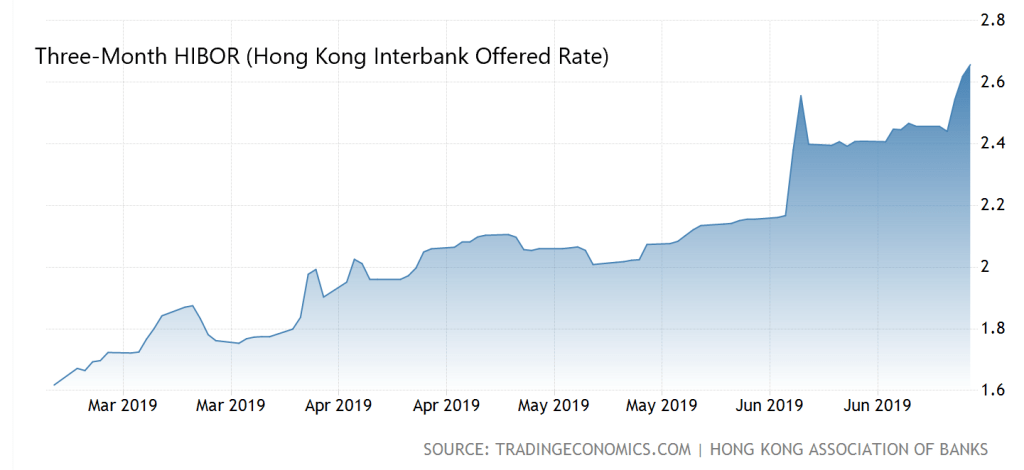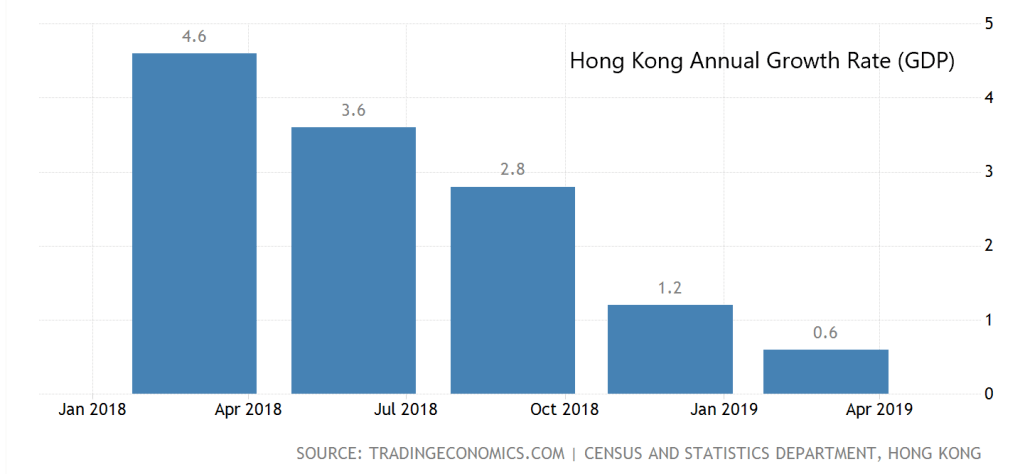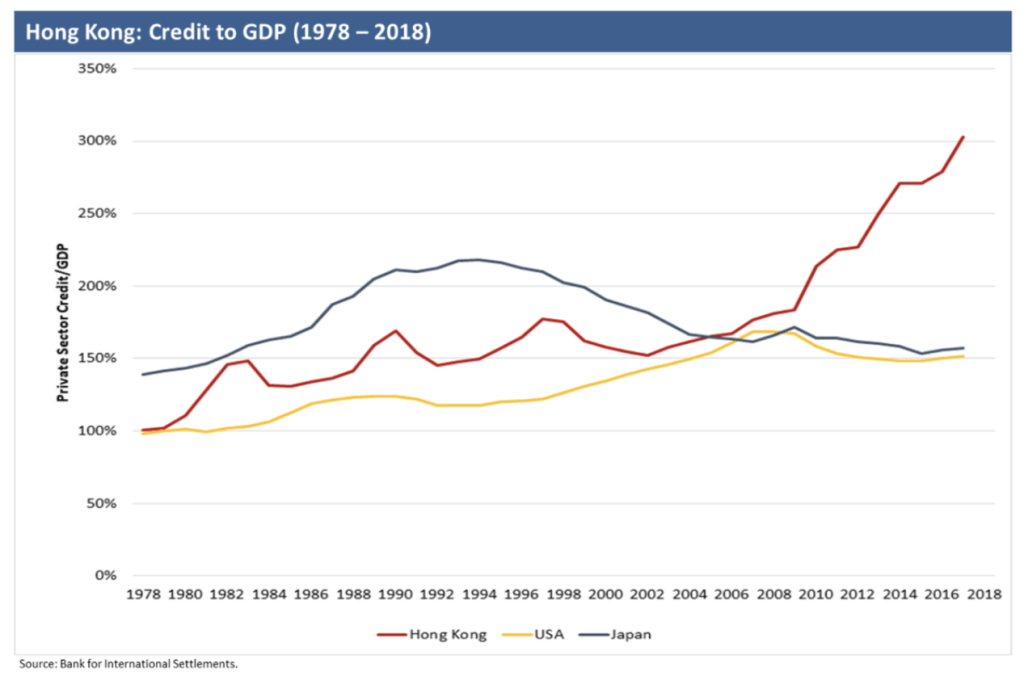Over the last few months – I’ve written about the sticky situation going on between the Hong Kong dollar (HKD) and the Hong Kong economy. And why I was shorting Hong Kong stocks via long-dated, out of money, put options.
But – to give you some quick context – since the Federal Reserve began aggressively tightening in 2018 (via rate hikes and Quantitative Tightening) – both the Hong Kong economy and HKD have been under pressure.
For instance – in March 2019 – the three-month USD rate (according to LIBOR – the London Interbank Offered Rate) was 2.63%. But the three-month HKD rate (according to HIBOR – the Hong Kong Interbank Offered Rate) was less than 1.75%.
That’s almost a 1.00% spread. . .
This created an arbitrage opportunity (known as a ‘carry trade’) for traders and depositors in Hong Kong to short the HKD and go long the USD instead.
Or – putting it another way – traders could borrow HKD at lower HIBOR rates, sell them on the market, purchase USD in return, and net almost 100 basis points more in ‘risk free’ yield.
Thus – there’s been a natural flow from the HKD to the USD.
And because of this – the HKD’s traded at the weakest edge of its currency peg from all this selling.
This forced the Hong Kong Monetary Authority (HKMA – Hong Kong’s central bank) to spend over 80% of their cash reserves (aka the ‘aggregate balance’) defending the peg.
That is – until recently. . .
Like I wrote back in March – unless the HKMA broke the HKD-USD peg (which wasn’t very likely), rates would eventually soar as the HKMA tightened liquidity – closing the yield-gap between the USD and HKD.
(Other reasons causing higher rates are corporations hoarding cash, increased public offerings, and banks trying to attract capital).
Thus – since March – the three-month HIBOR is up a staggering 100 basis points (1.00%).

This is a significant increase in short-term borrowing costs as liquidity dries up throughout Hong Kong. (Borrowing costs are now at their highest level since 2008).
Now – this is where things get interesting. . .
For starters – tighter liquidity (higher rates) does have some short-term upside.
The higher rates have effectively reversed the carry trade – meaning the HKD now yields more than the USD. (Especially as fears of recession have pushed U.S. rates and LIBOR much lower).
This caused traders and depositors to rush back into the HKD – lifting it to its highest level since 2017.

Thus – the HKD has been able to catch its breath – thanks to the higher rates.
But – keep in mind – higher rates act as a double-edged sword.
They’re actually pushing the anemic Hong Kong economy closer towards a ‘tipping point’.
Or – said otherwise – the sharply higher rates will put pressure on an already fragile Hong Kong economy and banking system.
Just take a look at Hong Kong’s annual growth rate (GDP) since early 2018. . .

It’s steadily declined over the last 16 months.
To put things into perspective – last quarter – Hong Kong’s economy grew at its slowest annual pace since 2008.
And the higher borrowing costs will only add to this economic weakness.
(Remember – higher interest rates during periods of slowing growth can tip an economy into a recession).
Making matters worse – the sharply higher rates won’t help those with mortgages and debts (both huge parts of the Hong Kong economy).
For instance – the majority of mortgages in Hong Kong are bench-marked to HIBOR (meaning if HIBOR rises – so do mortgage costs).
Also – Hong Kong’s private sector leverage is now the highest of any nation in the world at over 300% credit-to-GDP.

In my most recent Hong Kong article – I wrote: “Can the very leveraged Hong Kong economy, banking system, and property market handle higher rates? I believe it can’t. . .”
Well – I still feel the same.
And we’re soon going to find out as rates surge and liquidity continues drying up. . .
So – in summary – I expect the Hong Kong economy to continue weakening.
And while the tighter liquidity’s saved the HKD for now – it’s only increased long-term fragility.
That’s why – as I disclosed at the bottom of my previous article – I opened a position shorting Hong Kong via out of the money, long dated Put options on the iShares MSCI Hong Kong Index Fund (NYSE: $EWH).
I believed there were two reasonable scenarios for this trade to work out – making it asymmetric (low risk, high reward). . .
Scenario one: the much lower Hong Kong rates relative to LIBOR causes further HKD outflows. Forcing the HKMA to sell the rest of their dollar reserves – or eventually break the peg. This would send Hong Kong stocks down significantly as the HKD drops like a stone. (For now I believe this is a very unlikely event).
And scenario two: the short-term rates in Hong Kong soar as liquidity tightens and banks try to attract capital. This helps the HKD – but puts pressure on an already weak Hong Kong economy. Potentially pushing the country into recession – and putting the HKD-peg at risk (as the HKMA may have to break the peg to stimulate their economy – again, see my first article).
The soaring HIBOR is worrisome (but was expected) – and I believe it will last for some time.
So – for now – I’m holding my puts and waiting.
I still see greater downside risk than what the market’s pricing in.
The elephant in the room is what the Fed’s planning to do. If they begin easing (cutting rates) – that would most likely help the Hong Kong economy and the HKD.
Most analysts believe the higher borrowing costs are ‘seasonal’ and have nothing to do with capital outflows. But I’m not so sure about this.
